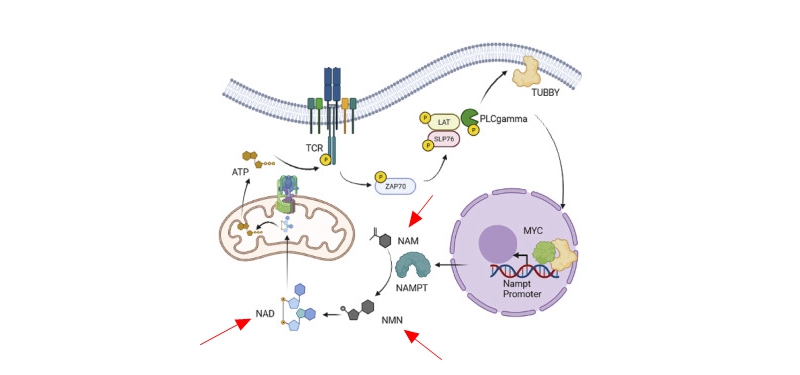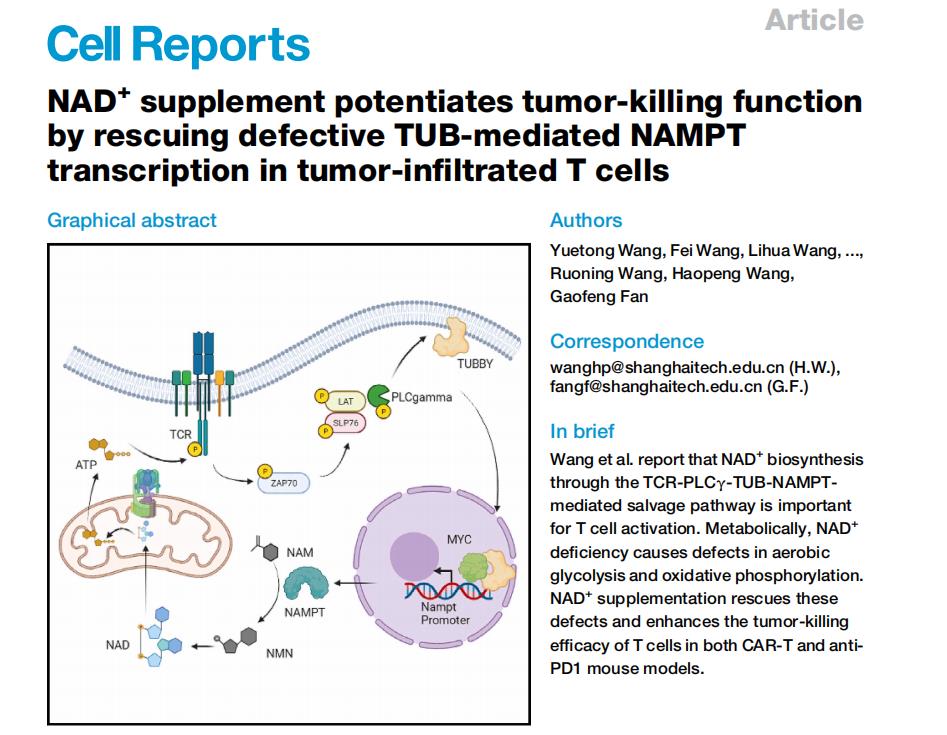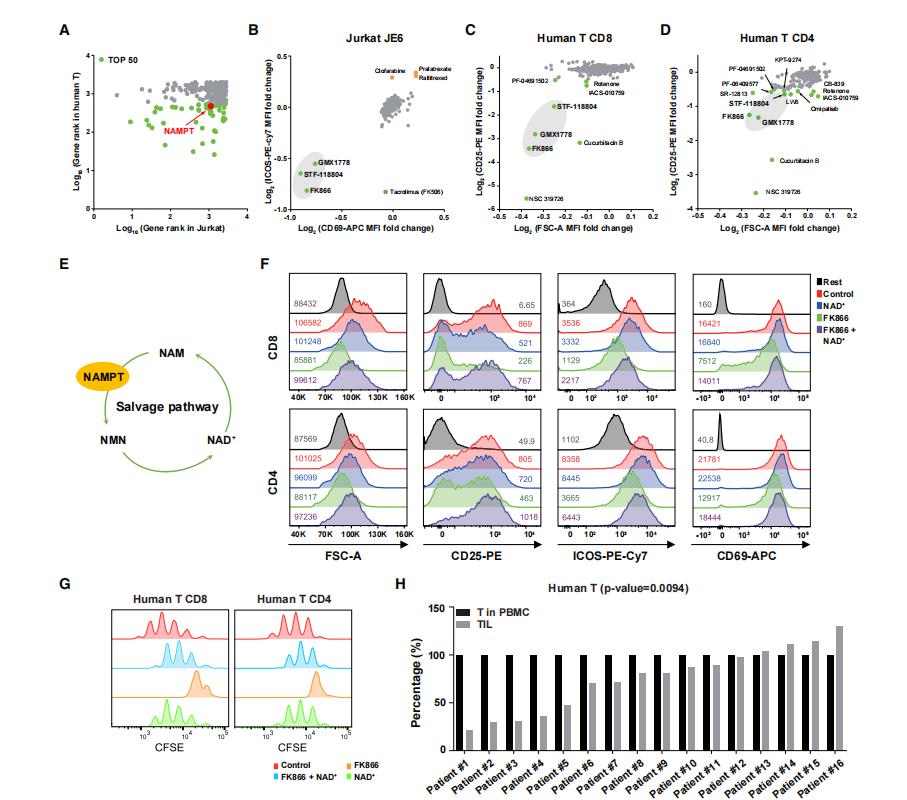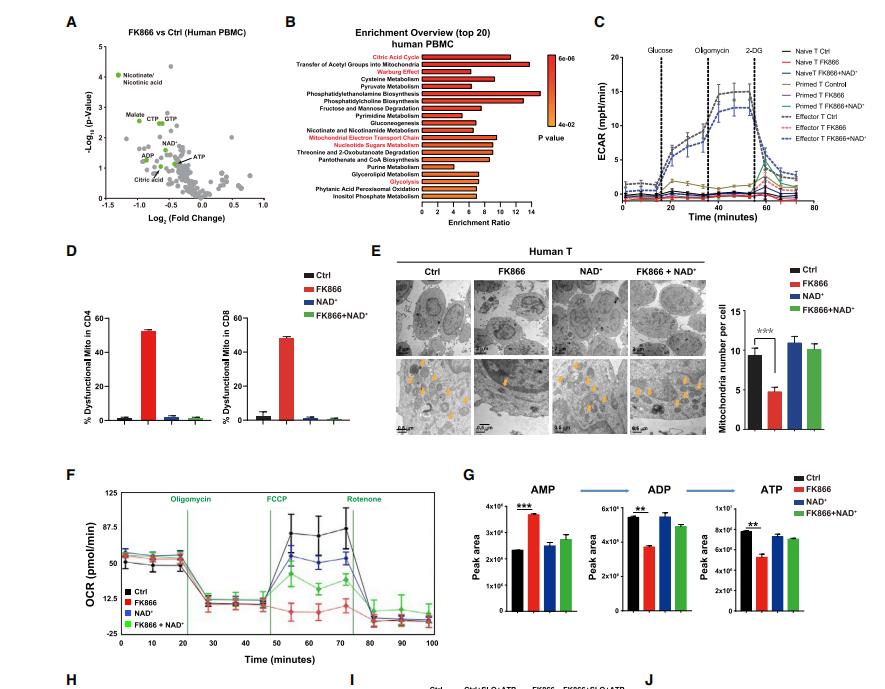
Source:
Release Time: 2021-08-12
1615 Views
On August 10, 2021, researchers from Shanghai University of Science and Technology published an article titled NAD+ supplement potentiates tumor killing function by rescuing defective TUBBY-mediated NAMPT transcription in tumor infiltrated T cells in Cell Reports, revealing that NAD+ in supplemented during CAR-T therapy and immune checkpoint inhibitor therapy, it can improve the anti-tumor activity of T.

At present, the supplementary precursor of NAD+, as a nutritional product,has been verified for human consumption safety.This achievement provides a simply and feasible new method for improving the anti-tumor activity of T cells.
Cancer immunotherapies including the adoptive transfer of naturally occurring tumor-infiltrating lymphocytes (TILs) and genetically engineered T cells, as well as the use of immune checkpoint blockade (ICB) to boost the function of T cells, have emerged as promising approaches to achieve durable clinical responses of otherwise treatment-refractory cancers (Lee et al., 2015; Rosenberg and Restifo, 2015; Sharma and Allison, 2015). Although immunotherapies have been successfully used in the clinic, the number of patients benefiting from them is still limited (Fradet et al., 2019; Newick et al., 2017). Tumor microenvironment (TME)-related immunosuppression has emerged as the major reason for low and/or no response to both immunotherapies (Ninomiya et al., 2015; Schoenfeld and Hellmann, 2020). Therefore, efforts to investigate and overcome TME-related limitations in immune therapies are of great urgency.

The fact that immune cells and cancer cells share many fundamental metabolic pathways implies an irreconcilable competition for nutrients in TME (Andrejeva and Rathmell, 2017; Chang et al., 2015). During uncontrolled proliferation, cancer cells hijack alternative pathways for more rapid metabolite generation (Vander Heiden et al., 2009). As a consequence, nutrient depletion, hypoxia, acidity, and generation of metabolites that can be toxic in the TME may hinder successful immunotherapy (Weinberg et al., 2010). Indeed, TILs often experience mitochondrial stress within growing tumors and become exhausted (Scharping et al., 2016). Interestingly, multiple studies also indicate that metabolic changes in TME could re-shape T cell differentiation and functional activity (Bailis et al., 2019; Chang et al., 2013; Peng et al., 2016). All these evidences inspired us to hypothesize that metabolic reprogramming in T cells might rescue them from a stressed metabolic environment, thereby reinvigorating their anti-tumor activity (Buck et al., 2016; Zhang et al., 2017).
In this current study, by integrating both genetic and chemical screens, we identified that NAMPT, a key gene involved in NAD+ biosynthesis, was essential for T cell activation. NAMPT inhibition led to robust NAD+ decline in T cells, thereby disrupting glycolysis regulation and mitochondrial function, blocking ATP synthesis, and dampening the T cell receptor (TCR) downstream signaling cascade. Building on the observation that TILs have relatively lower NAD+ and NAMPT expression levels than T cells from peripheral blood mononuclear cells (PBMCs) in ovarian cancer patients, we performed genetic screening in T cells and identified that Tubby (TUB) is a transcription factor for NAMPT. Finally, we applied this basic knowledge in the (pre) clinic and showed very strong evidence that supplementation with NAD+ dramatically improves the anti-tumor killing activity both in adoptively transferred CAR-T cells therapy and immune check point blockade therapy, indicating their promising potential for targeting NAD+ metabolism to better treat cancers.
1.NAD+ regulates the activation of T cells by affecting energy metabolism
After antigen stimulation, T cells undergo metabolic reprogramming, from mitochondrial oxidation to glycolysis as the main source of ATP. While maintaining sufficient mitochondrial functions to support cell proliferation and effector functions.Given that NAD+ is the main coenzyme for redox, the researchers verified the effect of NAD+ on the level of metabolism in T cells through experiments such as metabolic mass spectrometry and isotope labeling. The results of in vitro experiments show that NAD+ deficiency will significantly reduce the level of glycolysis, TCA cycle and electron transport chain metabolism in T cells. Through the experiment of replenishing ATP, the researchers found that the lack of NAD+ mainly inhibits the production of ATP in T cells, thereby reducing the level of T cell activation.

2.The NAD+ salvage synthesis pathway regulated by NAMPT is essential for T cell activation
The metabolic reprogramming process regulates the activation and differentiation of immune cells. Targeting T cell metabolism provides an opportunity to modulate the immune response in a cellular way. Immune cells in the tumor microenvironment, their own metabolic level will also be correspondingly affected. The researchers in this article have discovered the important role of NAMPT in the activation of T cells through genome-wide sgRNA screening and metabolism-related small molecule inhibitor screening experiments. Nicotinamide adenine dinucleotide (NAD+) is a coenzyme for redox reactions and can be synthesized through the salvage pathway, de novo synthesis pathway, and Preiss-Handler pathway. The NAMPT metabolic enzyme is mainly involved in the NAD+ salvage synthesis pathway. Analysis of clinical tumor samples found that in tumor-infiltrating T cells, their NAD+ levels and NAMPT levels were lower than other T cells. Researchers speculate that NAD+ levels may be one of the factors that affect the anti-tumor activity of tumor-infiltrating T cells.
3.Supplement NAD+ to enhance the anti-tumor activity of T cells
Immunotherapy has been exploratory research in cancer treatment, but the main problem is the best treatment strategy and the effectiveness of immunotherapy in the overall population. Researchers want to study whether enhancing the activation ability of T cells by supplementing NAD+ levels can enhance the effect of T cell-based immunotherapy. At the same time, in the anti-CD19 CAR-T therapy model and anti-PD-1 immune checkpoint inhibitor therapy model, it was verified that supplementation of NAD+ significantly enhanced the tumor-killing effect of T cells. The researchers found that in the anti-CD19 CAR-T treatment model, almost all mice in the CAR-T treatment group supplemented with NAD+ achieved tumor clearance, while the CAR-T treatment group without NAD+ supplemented only about 20 % Of mice achieved tumor clearance. Consistent with this, in the anti-PD-1 immune checkpoint inhibitor treatment model, B16F10 tumors are relatively tolerant to anti-PD-1 treatment, and the inhibitory effect is not significant. However, the growth of B16F10 tumors in the anti-PD-1 and NAD+ treatment group could be significantly inhibited. Based on this, NAD+ supplementation can enhance the anti-tumor effect of T cell-based immunotherapy.

4.How to supplement NAD+
The NAD+ molecule is large and cannot be directly absorbed and utilized by the human body. The NAD+ directly ingested orally is mainly hydrolyzed by brush border cells in the small intestine. In terms of thinking, there is indeed another way to supplement NAD+, which is to find a way to supplement a certain substance so that it can synthesize NAD+ autonomously in the human body. There are three ways to synthesize NAD+ in the human body: Preiss-Handler pathway, de novo synthesis pathway and salvage synthesis pathway. Although the three ways can synthesize NAD+, there is also a primary and secondary distinction. Among them, the NAD+ produced by the first two synthetic pathways only accounts for about 15% of the total human NAD+, and the remaining 85% is achieved through the way of remedial synthesis. In other words, the salvage synthesis pathway is the key to the human body to supplement NAD+.
Among the precursors of NAD+, nicotinamide (NAM), NMN and nicotinamide ribose (NR) all synthesize NAD+ through a salvage synthesis pathway, so these three substances have become the body's choice for supplementing NAD+.
Although NR itself has no side effects, in the process of NAD+ synthesis, most of it is not directly converted into NMN, but needs to be digested into NAM first, and then participate in the synthesis of NMN, which still cannot escape the limitation of rate-limiting enzymes. Therefore, the ability to supplement NAD+ through oral administration of NR is also limited .
As a precursor for supplementing NAD+, NMN not only bypasses the restriction of rate-limiting enzymes, but is also absorbed very quickly in the body and can be directly converted into NAD+. Therefore, it can be used as a direct, rapid and effective method to supplement NAD+.
Expert Reviews:
Xu Chenqi (Excellence and Innovation Center of Molecular Cell Science, Chinese Academy of Sciences, Immunology Research Expert)
Cancer treatment is a problem in the world. The development of immunotherapy has made up for the limitations of traditional cancer treatment and expanded the treatment methods of doctors. Cancer immunotherapy can be divided into immune checkpoint blocking therapy, engineered T cell therapy, tumor vaccine, etc. These treatment methods have played a certain role in the clinical treatment of cancer. At the same time, this also makes the current focus of immunotherapy research on how to further enhance the effect of immunotherapy and expand the beneficiaries of immunotherapy.